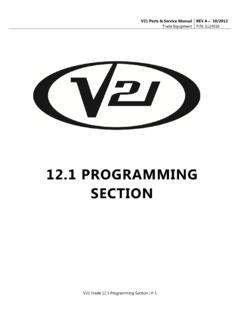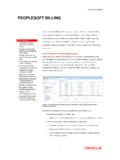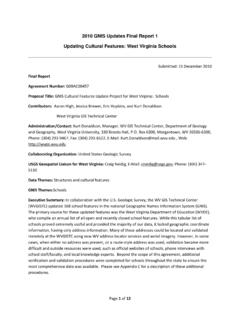Transcription of Editorial GuidE Wiring Harness innovations - …
1 Editorial GuidEWiring Harness innovationsThe industrial-grade Wiring Harness acts as the central nervous system to many device and vehicle electronics designs, particularly in the automotive and military-aerospace segments. As applications become increasingly complex, innovation in Wiring Harness design and manufacturing techniques becomes more critical. This Connector Specifier Editorial GuidE investigates methods for more efficiently driving design data toward fully automated assembly processes, as well as ways to better analyze costs, to help ensure the successful design and manufacture of new Wiring Harness products. 2 Driving Wiring Harness design data toward manufacturing 13 Benefits of fully automated wire Harness assembly 17 Building Wiring harnesses to save costs sponsorEd by:Connector Specifier :: Editorial GUIDE2 Driving Wiring Harness design data toward manufacturingBy ELIsA POUyAnnEtHE ElEctrical distribution system (EDS) design process for automobiles and other transportation platforms is basically a sequence of steps performed in more or less serial fashion.
2 The stages in the process begin with requirements definition, systems design and engineering and extend all the way through Harness engineering including manufacturing documentation. The process as a whole must be organized to create manufacturable Harness products that support the requirements (design intent) and meet the enterprise s quality and cost each stage has been an island with its own design tools and a complex local dialect that describes the components, inputs and outputs of the particular stage. Communication between the stages has often been cumbersome, requiring conversions and/or manual data re-entry at the input to each the historical methods cannot meet the time, cost, and competitive pressures of the modern design realm. It is simply no longer feasible for consumer vehicle makers to live with the redundancy and delays that result from passing lumped data from island to island in the process. As a result, innovative software-based solutions have emerged to address these concept of digital continuityThe solution for today s time, cost, and competitive pressures is a concept known as digital continuity.
3 In such an environment, data flows from one development stage to another without duplication, disconnection, or data re-entry. True digital continuity also enables critical information to cross to, and from, related processes occurring in parallel within the enterprise. These include: concurrent design using MCAD tools; Harness configuration management; component Driving Wiring Harness design data toward manufacturing3 Connector Specifier :: Editorial GuidE inventory processes and databases; and product lifecycle management via Product data Management (PDM) other issues have an impact on the nature of digital continuity. First, design changes are inevitable sometimes a daily occurrence. A toolset that supports intelligent rules-driven design change management is essential. Only then can reliable up-to-date data propagate across domains and teams and over organizational and geographical secondly, reaching the final stage in the design flow doesn t guarantee that the product will comply with the original design intent, reliability guidelines, and manufacturability objectives.
4 But with the data accumulated over the course of the entire flow, it is relatively easy to confirm that goals and cost expectations have been does digital continuity begin? At the very earliest planning and requirements definition stage. Enterprise-wide databases are a medium for continuity, as are consistent, compatible interfaces among the various development stages. A key enabling factor is a design toolset that raises the level of abstraction and automates more tasks. If an engineer can work with higher-level entities and symbols, then these entities can bring embedded knowledge of their own characteristics and behavior to the design. This in turn supports real-time rules checking, what-if prototyping, and more. data continuity embodies data unification, integration, verification, and Harness design Flow, From specification to ManufacturingHarness development is a transition point in the vehicle design and manufacturing process. It is the environment in which critical design data matures into a buildable product.
5 Modern ECAD software supports this process by enabling and imposing digital continuity. It spans process stages ranging from the earliest design effort (where electrical functional requirements and physical requirements are captured) to implementation. The deliverable is a completed Harness product and ideally, thorough documentation to accompany 1 illustrates the concept of the design flow and symbolizes the digital continuity as data passes from stage to stage. Each step in the flow receives and Driving Wiring Harness design data toward manufacturing4 Connector Specifier :: Editorial GuidE matures relevant information from all preceding stages. New design data is of course generated in each successive step for use within that step. But each step also evolves the data received from the steps that precede it. As Figure 1 implies, the volume of data increases with each step forward. The data from the Logical Architecture stage, for example, passes to the Systems Design stage where it becomes an integral part of that stage s data , which in turn gets passed on.
6 This flow underscores the importance of both consistent interfaces from step to step and data versioning and release management. Typically the data content is communicated via one or more and applying the design intent Design intent arises from the Requirements and Architecture stages at the beginning of the process depicted in Figure 1. Intent includes not only a description of the functional needs that must be satisfied, but also details such as weight and above all, cost. It also includes methods to help designers satisfy these functional requirements. Harness engineers are responsible for achieving in general terms the design intent and requirements, including some constraints on installation into the vehicle, all in the context of a manufacturable Harness definition is at the crossroads of data from the electrical Wiring design and the digital Harness layout mock up. Ideally it accounts for the diverse Figure 1: Digital continuity implies a series of smooth transitions among all the steps of the design flow.
7 Each process step (stage) contributes data to the subsequent steps. This information is preserved and reused, maturing as it moves ahead in the Wiring Harness design data toward manufacturing5 Connector Specifier :: Editorial GuidE configurations that will be needed to support variations in the Harness electrical content. The design department s deliverable is a completed drawing that may form the basis of contracts between OEMs and Tier 1 suppliers, and is ready to be further processed by the Harness engineering distinction between the disciplines of Harness design and Harness engineering may not be clear to those unfamiliar with Harness development. The Harness emerges from the design department complete in concept but not necessarily ready for production::: It may not contain all the data required to physically build the Harness .:: It may need to be enriched with certain parts necessary to support assembly of the Harness into the vehicle.
8 :: It may call out specification criteria rather than actual part numbers to describe wires, connectors and components.:: It may be authored as a superset/composite with the expectation that these will be broken down into variants/derivatives.:: It may embody some requirements that are unachievable and others that don t conform to best the next step is Harness engineering, which transforms the design intent into usable manufacturing data . Figure 2 shows how multiple inputs are combined in the Harness design and engineering stages to create manufacturing and business data that is ready to use throughout the from design to realityThe Harness engineer is assigned to produce a 100% accurate, error free data set per variant/derivative that can be fully costed and passed on to production for assembly. He or she must generate the full BOM and validate it against the design intent. Again, accuracy is crucial because the product is destined for high-volume manufacturing, where the cost of an error is multiplied by thousands or even millions of effect, the engineering phase of the process brings theory and planning face-to-face with reality, where reality includes laying out formboards, programming Driving Wiring Harness design data toward manufacturing6 Connector Specifier :: Editorial GuidE test and production equipment, defining tooling requirements and wire cutting charts, and making cost calculations.
9 Software tools selected for the process must provide a 2D design environment supporting the large variety of Harness components including bundle protections, clips and grommets, cavity components, and more. In turn this environment must be automated to help Harness engineers manage discretionary steps including::: Component selection Wires, terminals, seals, plugs, tapes, tubes must accommodate OEM specifications. For example, an OEM might specify a basic clip position but the Harness maker must define the taping that surrounds it.:: Splice position optimization and balancing Here the Harness builder must meet manufacturing and quality rules, including customized rules such as the choice of waterproofing materials ( , heat-Figure 2: The Harness design and engineering process accepts data in diverse formats and delivers the drawings, costing data , and BOMs needed for Wiring Harness design data toward manufacturing7 Connector Specifier :: Editorial GuidE shrink sleeves).
10 Similarly the OEM might specify a shielded cable while leaving it to the Harness maker to define the solder-sleeve position and the drain wire connection.:: Wire-color optimization The Harness provider must allocate wire-color definitions for manufacturing and service while taking the wire inventory into account::: Component sourcing verification:: Assembly time calculation/prediction:: BOM calculation Engineering for manufacturability means different things to different people but most agree that it encompasses activities such as splice optimization and component selection; that part of the task is to confirm the availability of the selected components from preferred suppliers; and that there is an overarching responsibility to ensure that all contractual obligations with the OEM are 3 summarizes all these steps and this must be done within the constraints of the very low margins that characterize the contract Harness market. Production is often geographically widespread and logistically complex, making it difficult, but critical, to accurately predict product cost.







